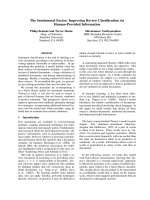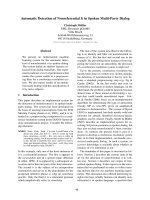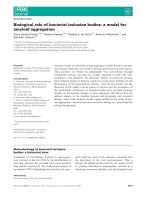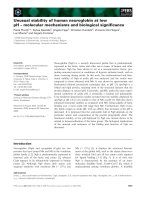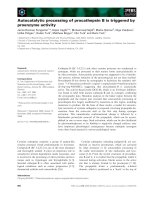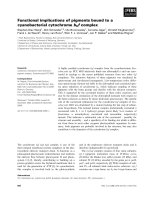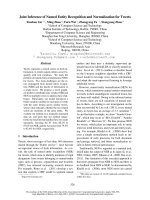báo cáo khoa học: " The extent of the psychological impairment of prosthodontic outpatients at a German University Hospital" doc
Bạn đang xem bản rút gọn của tài liệu. Xem và tải ngay bản đầy đủ của tài liệu tại đây (264.6 KB, 8 trang )
BioMed Central
Page 1 of 8
(page number not for citation purposes)
Head & Face Medicine
Open Access
Research
The extent of the psychological impairment of prosthodontic
outpatients at a German University Hospital
Michelle A Ommerborn
1
, Alfons Hugger
2
, Johannes Kruse
3
,
Jörg GK Handschel
4
, Rita A Depprich*
4
, Ulrich Stüttgen
2
, Stefan Zimmer
5
and WolfgangHMRaab
1
Address:
1
Department of Operative and Preventive Dentistry and Endodontics, Heinrich-Heine-University Düsseldorf, Moorenstr. 5, 40225
Düsseldorf, Germany,
2
Department of Prosthodontics, Heinrich-Heine-University Düsseldorf, Moorenstr. 5, 40225 Düsseldorf, Germany,
3
Clinical Institute of Psychosomatic Medicine and Psychotherapy, Heinrich-Heine-University Düsseldorf, Moorenstr. 5, 40225 Düsseldorf,
Germany,
4
Department of Cranio- and Maxillofacial Surgery, Heinrich-Heine-University Düsseldorf, Moorenstr. 5, 40225 Düsseldorf, Germany
and
5
Department of Operative and Preventive Dentistry, University of Witten/Herdecke, Alfred-Herrhausen-Str. 50, 58448 Witten, Germany
Email: Michelle A Ommerborn - ; Alfons Hugger - ;
Johannes Kruse - ; Jörg GK Handschel - ; Rita A Depprich* -
duesseldorf.de; Ulrich Stüttgen - ; Stefan Zimmer - ;
Wolfgang HM Raab -
* Corresponding author
Abstract
Background: Psychological factors are not only important in patients with temporomandibular disorders
(TMDs), but also in patients suffering from tooth loss and/or in those awaiting prosthodontic care with fixed or
removable dentures as several authors emphasize. The purpose of the present prospective observational study
was to compare prosthodontic outpatients of the Department of Prosthodontics at the University of Duesseldorf
and patients seeking care at the TMD/Orofacial Pain Outpatient Clinic (TMD/OFPOC) at the same university with
respect to sociodemographic data, self-reported somatic complaints, and psychological impairment.
Methods: A total of 234 patients received two self-administered questionnaires including the Symptom-Check-
List. Complete data have been obtained from 65 prosthodontic outpatients and 60 patients of the TMD/OFPOC.
Results: Results indicated statistically significant group differences regarding sociodemographic data and somatic
complaints. Concerning the latter, in 11 of the 21 items, groups differed significantly and confirmed the absence
of any mixing between the two outpatient clinics. Although the evaluation of psychological impairment revealed
no significant group differences, in 21.9% of the prosthodontic outpatients and in 22.0% of the patients from the
TMD/OFPOC, the extent of the determined psychological impairment was similar to that of psychotherapeutic
outpatients; in 9.4% and 8.5% it was similar to that of psychotherapeutic inpatients, respectively.
Conclusion: Within the limitations of this study, in approximately one third of the evaluated patients of both the
prosthodontic outpatient clinic and the TMD/OFPOC the psychological impairment reached values comparable
to those of psychotherapeutic outpatients and psychotherapeutic inpatients. Therefore, the present findings
emphasize the need to intensify the integration of psychosomatic aspects into dentistry and, in particular, to add
psychological considerations to future German education plans.
Published: 23 October 2008
Head & Face Medicine 2008, 4:23 doi:10.1186/1746-160X-4-23
Received: 26 September 2007
Accepted: 23 October 2008
This article is available from: />© 2008 Ommerborn et al; licensee BioMed Central Ltd.
This is an Open Access article distributed under the terms of the Creative Commons Attribution License ( />),
which permits unrestricted use, distribution, and reproduction in any medium, provided the original work is properly cited.
Head & Face Medicine 2008, 4:23 />Page 2 of 8
(page number not for citation purposes)
Background
While the prosthodontic management of patients with
fixed partial dentures, removable partial dentures, and
complete dentures represents a routine situation in daily
dental practice, a lot of patients have difficulties adapting
to the sensation of a foreign body [1]. This may be due to
the fact that the oral environment is an extremely sensitive
region [2] which can be affected by both physical and psy-
chological stressors [1]. To give an example for physical
impairment as a result of prosthodontic management:
wearing removable partial or complete dentures often
impairs masticatory function and speech transiently [2,3].
Further physical problems such as soreness of denture-
supporting tissues, tooth movement, carious lesions at the
abutment teeth [4], and temporomandibular disorders
[1,5] have been documented. Apart from these physical
reasons that may potentially cause problems following
prosthodontic management, several authors also under-
line the role of psychological factors in the process of
accepting removable dentures and adapting to them [3,5-
7].
In general, psychological response to tooth loss and den-
ture wearing may be influenced by the patient's personal-
ity and, thus, may sometimes depend less on the technical
quality of the dentures [3]. For instance, one investigator
found somatization to be a factor in general dental prac-
tice per se [8], whereas some researchers assumed subjec-
tive body complaints to be an indicator of somatization
particularly in elderly patients [9]. Hence, a clear associa-
tion between age and irreversible complications during
prosthetic rehabilitation has been found [10] and, eventu-
ally, many of these patients are referred to specialized den-
tal clinics, such as prosthodontic outpatient clinics at
university hospitals.
Another group of patients that is typically referred to spe-
cial university-based care clinics consists of patients suffer-
ing from temporomandibular disorders (TMDs).
Although various factors, such as anatomy, trauma,
pathophysiology, and psychology have been suggested to
be involved in the development of TMD, the etiology has
not definitely been clarified so far [11-14]. According to
the literature, psychosocial factors have become a field of
increasing interest. For instance, several studies have
clearly indicated that compared to matched controls TMD
patients had higher levels of psychological distress,
including anxiety, somatization, and depression [15-17].
Considering this and the fact that typically both prostho-
dontic outpatient clinics and TMD/orofacial pain outpa-
tient clinics are university-based care centers, patients in
these institutions were not really found to be representa-
tive and thus cannot easily be compared with patients
from a general dental practice. In particular, the extent of
psychological impairment of patients seeking care at a
prosthodontic outpatient clinic (POC) was regarded to be
more obvious than in those patients that usually turn to
their general dental practitioner. Hence, a comparison of
patients of two different outpatient clinics appears to be
more appropriate for the evaluation. Moreover, given the
fact that these outpatient clinics take part in university
education programs, potentially beneficial insights result-
ing from such observational investigation might have a
favorable effect on future education plans. Therefore, the
purpose of the present prospective observational study
was to compare patients of a POC of the Department of
Prosthodontics at the University of Duesseldorf with
patients seeking care at the TMD/Orofacial Pain Outpa-
tient Clinic (TMD/OFPOC) at the same university. We
examined sociodemographic data, self-reported somatic
complaints, and psychological impairment. The hypothe-
sis used in this investigation was that groups differ signif-
icantly regarding their sociodemographic data and self-
reported somatic complaints. Conversely, it was expected
that there is no difference between both groups regarding
the extent of psychological impairment.
Methods
Sample
Following written informed consent obtained by each
patient, a total of 234 subjects, 148 females and 86 males,
with a mean age of 49.24 ± 15.73 years (range 15 to 89
years), participated in this investigation. One hundred
patients who sought care at the POC of the Department of
Prosthodontics at the University of Duesseldorf were con-
tinuously recruited. This group of patients consulted the
POC predominantly for detailed advice and/or treatment
planning of a new prosthodontic restoration or concern-
ing the repair of a damaged or insufficient prosthodontic
restoration, and the presence of dental pain.
In addition, 134 patients seeking care at the TMD/OFPOC
at the same university for the management of TMD were
also included. As derived from the individual index cards,
at the first appointment each patient was previously sub-
jected to a detailed dental functional examination of the
masticatory system which had been performed by one
trained dentist. According to the Research Diagnostic Cri-
teria for Temporomandibular Disorders (RDC/TMD)
[18], the most frequently determined diagnoses were:
myofascial pain, anterior disc displacement, arthralgia,
osteoarthritis, and osteoarthrosis. Additionally, signs of
bruxism have been documented using the clinical criteria
of the American Academy of Sleep Medicine for the diag-
nosis of sleep bruxism [19].
With respect to the observational character of the present
investigation no specific inclusion or exclusion criteria
were determined. Regarding the application of psycho-
Head & Face Medicine 2008, 4:23 />Page 3 of 8
(page number not for citation purposes)
metric instruments, the only limitation for a participation
in this study was that each participant was required to
have good German language skills.
Design and instruments
At the visit of either the TMD/OFPOC or the POC of the
Department of Prosthodontics subjects completed two
questionnaires. In total, the hand out of the question-
naires took place over a time period of seven months.
Additionally, further descriptive data have been derived
from their index cards. To assess sociodemographic and
descriptive data (Table 1), a form had been prepared and
was given to each subject.
For the assessment of individual somatic complaints each
participant received a self-administered questionnaire to
be completed by each individual. As shown in Table 2, it
consists of 21 items assessing temporomandibular symp-
toms, dental complaints and details which have been fre-
quently reported by patients from the TMD/OFPOC.
The Revised Symptom Checklist (SCL-90-R) is a world-
wide used psychometric instrument with a high internal
consistency and test-retest reliability [20-22] and in the
present study it was applied in its standardized German
version [23,24]. It consists of 90 items and determines the
subjectively rated psychological distress that has been
obtained during the past seven days. Respondents rated
each item on a 5-point Likert scale (from "not at all" = 0
to "extremely" = 4). These 90 items were summarized to
nine subscales which measure different psychological
symptoms (somatization, obsessive-compulsive, interper-
sonal sensitivity, depression, anxiety, hostility, phobic
anxiety, paranoid ideation, and psychoticism). As a total
score of psychological impairment, the Global Severity
Index (GSI) was also applied.
In addition, to estimate the clinical relevance of the
obtained results, the distribution of the GSI values of both
patients from the POC and patients from the TMD/
OFPOC were compared with the previously determined
and published GSI values of a normative sample, a sample
of psychotherapeutic outpatients, and a sample of psycho-
therapeutic inpatients. The estimation of these reference
values has been described in detail elsewhere [25]. Briefly,
if the GSI values collected these three samples have been
graphed, at a GSI value of 0.65 the distributional curve of
the psychotherapeutic outpatient sample exceeded the
curve of the normative sample. At a GSI value of 1.35 the
distributional curve of the inpatient psychotherapeutic
Table 1: Comparison of patients from the POC vs. patients from the TMD/OFPOC regarding sociodemographic and descriptive data
(percentages shown in parentheses)
Patients from the POC (n = 65) Patients from the TMD/OFPOC (n = 60) p
Age (years) 53.03 ± 14.09 43.45 ± 14.01 ***
a
Range (years) 26 to 81 17 to 75
Gender 31 F; 34 M 49 F; 11 M ***
b
Number of children 1.22 ± 1.08 1.02 ± 1.08 n. s.
c
Education (%) n. s.
b
10 years of school 48 (73.8) 38 (63.3)
12 years of school 7 (10.8) 9 (15.0)
13 years of school 10 (15.4) 12 (20.0)
No graduation 0 (0) 1 (1.7)
Marital status n. s.
b
Single 14 (21.5) 16 (26.7)
Married 40 (61.5) 31 (51.7)
Divorced 5 (7.7) 8 (13.3)
Widowed 4 (6.2) 2 (3.3)
Re-married 2 (3.1) 3 (5.0)
Residence (1 missing) n. s.
b
Duesseldorf 39 (60.9) 26 (43.3)
Up to 25 km outside of Duesseldorf 10 (15.6) 8 (13.3)
More than 25 km outside of Duesseldorf 15 (23.4) 26 (43.3)
Duration of complaints (months) (3 missing) 32.81 ± 90.6 43.50 ± 80.41 ***
c
Type of referral (8 missing) **
b
Referred by general dentist 16 (26.7) 30 (52.6)
Without referral 34 (56.7) 14 (24.6)
Miscellaneous 10 (16.7) 13 (22.8)
n. s. = not significant; * = p < 0.05; ** = p < 0.01; *** = p < 0.001
a
Two-sample, two-tailed t test; data are presented as means ± standard deviations (SD)
b
Chi-square test
c
Mann-Whitney U test; data are presented as means ± standard deviations (SD)
Head & Face Medicine 2008, 4:23 />Page 4 of 8
(page number not for citation purposes)
sample exceeded the curve of the psychotherapeutic out-
patients. Concluding from these previously performed
clinical group comparisons, in the present study the mag-
nitude of psychological impairment of patients with a GSI
value ≤ 0.65 was assigned to the field of the normative
sample, that of patients with a GSI value ranging >0.65
and <1.35 to the field of psychotherapeutic outpatients,
and that of patients with a GSI value ≥ 1.35 was seen in the
field of psychotherapeutic inpatients, respectively.
Missing data
Generally, subjects that had more than one missing item
in the form collecting sociodemographic and descriptive
data and, additionally, one or more missing item in the
questionnaire to determine individual somatic com-
plaints were excluded. According to these criteria, 109
subjects were not included in the analysis. This drop-out
sample consisted of 68 females and 41 males.
Finally, the remaining 125 subjects included 65 patients
from the POC and 60 patients from the TMD/OFPOC.
Thus, the average response rate amounted to 53.4%. The
data of two participants were not included, because the
amount of missing items in the SCL-90-R compromised
the calculation of the summary score. The maximum crit-
ical values of missing items still allowing the calculation
of the subscales and the summary score, viz, the GSI, have
been published elsewhere [24].
Statistical analysis
The statistical analysis was performed using the statistical
software "SPSS" Version 14.0. Normal distribution was
tested by using the Kolmogorov-Smirnov-Test along with
an assessment of histograms. The analysis of group differ-
ences between patients from the POC and patients from
the TMD/OFPOC was carried out for most of the predom-
inantly qualitative variables (e.g., gender, education,
items of the somatic questionnaire) by using Chi-square
test. Independent samples t test was only performed for
age which was normally distributed as tested by Kol-
mogorov-Smirnov-Test. For all quantitative variables that
were not normally distributed (e.g., duration of com-
plaints, subscales of the SCL-90-R), differences were eval-
uated by means of the Mann-Whitney U test. When using
the Mann-Whitney U test, the adequate statistical values
are the mean ranks and the sum of ranks. However, to
improve the comparability of the obtained results, data
are presented as means and standard deviations (SD). For
all statistical analyses an α-error probability of p < 0.05
was adopted as the statistically significant level.
Results
As seen in Table 1, the comparison between patients from
the POC and patients from the TMD/OFPOC revealed sta-
tistically significant differences with respect to age, gen-
der, the duration of complaints, and the type of referral,
whereas the evaluation of further sociodemographic vari-
Table 2: Frequency distribution of several somatic complaints reported by patients from the POC and patients from the TMD/OFPOC
(percentages shown in parentheses)
Patients from the POC (n = 65) Patients from the TMD/OFPOC (n = 60) p
Joint clicking 13 (20.0) 46 (76.7) ***
Other TMJ sounds 3 (4.6) 14 (23.3) **
Impaired mouth opening 8 (12.3) 36 (60.0) ***
Impaired mouth closing 7 (10.8) 13 (21.7) n. s.
Impaired chewing 11 (16.9) 36 (60.0) ***
Masticatory muscle fatigue 5 (7.7) 19 (31.7) **
Masticatory muscle stiffness 4 (6.2) 20 (33.3) ***
Extensive prosthodontic management prior to consultation 48 (73.8) 33 (55.0) *
Extensive orthodontic management prior to consultation 16 (24.6) 20 (33.3) n. s.
Extensive surgical management prior to consultation 21 (32.3) 19 (31.7) n. s.
Extensive occlusal adjustment prior to consultation 22 (33.8) 18 (30.0) n. s.
Presence of habits 4 (6.2) 9 (15.0) n. s.
Nail biting 2 (3.1) 1 (1.7) n. s.
Lip biting 2 (3.1) 8 (13.3) *
Smoking 13 (20.0) 10 (16.7) n. s.
Tooth hypersensitivity 23 (35.4) 22 (36.7) n. s.
Disturbance of a single tooth 8 (12.3) 14 (23.3) n. s.
Pain upon wide mouth opening 6 (9.2) 37 (61.7) ***
Mouth dryness/burning mouth 17 (26.2) 21 (35.0) n. s.
Need of a specific position to correctly close the mouth 9 (13.8) 26 (43.3) ***
Self-assessment of treatment need 29 (44.6) 54 (90.0) ***
For group comparisons Chi-square test was applied: n. s. = not significant; * = p < 0.05; ** = p < 0.01; *** = p < 0.001
Head & Face Medicine 2008, 4:23 />Page 5 of 8
(page number not for citation purposes)
ables, such as education, marital status, and residence,
showed no significant differences between both groups
(Chi-square; p = n.s. = not significant). Considering the
career, patients from the TMD/OFPOC were significantly
more ambitious than patients from the POC. To specify
only the most relevant groups, 20% of patients from the
POC and 43.3% of patients from the TMD/OFPOC were
employed, 9.2% and 13.3% were in leading positions,
18.5% and 13.3% were housewives, and 30.8% and 8.3%
were pensioners, respectively (Chi-square test; p < 0.05).
In 11 of the 21 items, the analysis of the distribution of
somatic complaints revealed the following statistically sig-
nificant differences (Table 2): patients from the TMD/
OFPOC reported more frequently joint sounds in general,
an impaired mandibular movement or function (such as
opening, yawning, chewing), masticatory muscle discom-
fort, problems to correctly bring maxillary and mandibu-
lar teeth together as well as oral habits like lip biting.
Moreover, these patients stated that, immediately prior to
the consultation, they did not receive as much extensive
prosthodontic rehabilitation as patients from the POC.
Finally, patients from the TMD/OFPOC unambiguously
expressed the necessity of their complaints to be treated.
Considering psychological impairment due to distress
perceived during the past seven days, the comparison of
the two clinical groups did not show any differences
between both groups (Table 3). In neither a subscale nor
in the GSI statistically significant group differences were
obtained. To estimate the clinical relevance of the
recorded data, the above described reference values were
applied (Table 4). In consideration of these reference val-
ues, no group specific differences were observed again.
Even though data failed to reach the level of statistical sig-
nificance, on the basis of the present findings, the GSI val-
ues of 31.3% of patients from the POC and 30.5% of
patients from the TMD/OFPOC were clearly located
above the GSI values that were obtained from a normative
sample. In 21.9% of patients from the POC and in 22.0%
of patients from the TMD/OFPOC, the extent of the deter-
mined psychological impairment reached values that
were in the range of psychotherapeutic outpatients and,
moreover, in 9.4% and in 8.5% values in the range of psy-
chotherapeutic inpatients, respectively (Chi-square; p =
n.s. = not significant).
Discussion
This prospective observational clinical study compared
patients from the POC at the University of Duesseldorf
with patients from the TMD/OFPOC at the same univer-
sity regarding sociodemographic data, self-reported
somatic complaints, and psychological impairment. As a
major finding, the results clearly demonstrated that the
degree of psychological impairment was similarly high in
both groups. Interestingly, in approximately one third of
the evaluated patients of both the POC and the TMD/
OFPOC the psychological impairment reached values that
were located in the range of psychotherapeutic outpa-
tients and psychotherapeutic inpatients. Indeed, this
important finding supports numerous studies which
revealed psychological characteristics in TMD patients
[13-17,26-28]. Moreover, these results particularly stress
the fact that patients from a POC represent a different
group of patients showing a similar pronounced psycho-
logical impairment than do TMD patients.
Apart from dentistry, previous investigations have
recorded the urban prevalence of psychiatric disorders in
general practices. While depressive and anxiety disorders
were detected in 15% to 25% of the patients from a gen-
eral practice [29], surveys which have analyzed the entire
prevalence of psychiatric disorders obtained values rang-
ing from 21% to 52% [25,30-33]. With respect to the por-
tion of psychologically impaired patients, it might be
concluded that the present values established in the two
Table 3: Comparison of patients from the POC vs. patients from the TMD/OFPOC regarding the SCL-90-R subscales and the GSI
values
Patients from the POC (n = 64) Patients from the TMD/OFPOC (n = 59)
Mean SD Mean SD p
Somatization 6.97 8.36 8.71 7.78 n. s.
Obsessive-compulsive 6.08 6.62 6.51 5.70 n. s.
Interpersonal sensitivity 4.91 6.57 4.07 4.63 n. s.
Depression 7.81 9.53 7.14 7.5 n. s.
Anxiety 4.67 7.52 4.68 5.02 n. s.
Hostility 2.69 4.16 2.36 2.63 n. s.
Phobic anxiety 2.30 5.18 1.19 2.48 n. s.
Paranoid ideation 3.59 4.51 2.98 3.71 n. s.
Psychoticism 3.44 4.99 3.25 4.57 n. s.
GSI 0.517 0.621 0.496 0.434 n. s.
For group comparisons the Mann-Whitney U test was applied: n. s. = not significant; * = p < 0.05; ** = p < 0.01; *** = p < 0.001
Head & Face Medicine 2008, 4:23 />Page 6 of 8
(page number not for citation purposes)
university-based care centers are largely comparable to
that derived from general practices.
Potential reasons for the magnitude of psychological
impairment found in patients from a POC might be due
to the reciprocal influences of tooth loss or denture wear-
ing and psychological factors. For instance, some previous
investigators suggested that the psychological response to
tooth loss and denture wearing may be affected by
patients' personality traits, sometimes more than by the
technical quality of the dentures [3,6]. Conversely, tooth
loss is reported to cause psychological impairment [3]
and, moreover, previous investigators have shown that it
contributes to a reduced quality of life [34].
The sociodemographic and reported somatic complaints
data showed significant differences between the two
groups, especially concerning age, gender, and most of the
characteristic TMD symptoms. These findings were
detected as a result of the sample composition. The une-
quivocal differentiation of the two groups by means of the
reported somatic complaints, underlines the absence of
any mixing between the two outpatient clinics. It might
have been expected that patients suffering from tooth loss
and, consequently, seeking prosthodontic management
were on an average older than a group of patients from a
TMD/OFPOC. Interestingly, in contrast to the patients
from the TMD/OFPOC the prosthodontic outpatients
revealed a comparatively balanced gender distribution.
Most of these patients sought care at the POC due to
apparently somatic reasons such as the improvement of
mastication or speech. The reasons differ from those
reported by patients from the TMD/OFPOC. Potentially,
such motives do not require a greater health awareness
[35,36] or specific experiences with the health care system
[37] as they have been discussed to explain the pro-
nounced female proportion in TMD patients.
Notwithstanding that groups differed with respect to age
and gender, the comparison of patients of these two uni-
versity-based care centers was found suitable for the fol-
lowing reasons: although previously several authors have
discussed the interaction between psychological factors
and tooth loss and/or subsequent prosthodontic manage-
ment with removable dentures [3,5-7], to date, little is
known of the extent of psychological impairment in
patients seeking care for prosthodontic rehabilitation.
Consequently, in a first exploratory approach patients col-
lected from a POC should be investigated. Indeed,
patients from a university-based care center represent a
highly specific sample that may not easily be compared
with patients from a general dental practice. However, if
sociodemographic data of the patients seeking care at the
POC of the Department of Prosthodontics at the Univer-
sity of Duesseldorf are compared with data derived from
other German prosthodontic departments, they appear to
be representative for these specific German care centers
[34,38]. Regarding an adequate control group for the
patients from the POC, a decision was made to investigate
patients from a TMD/OFPOC at the same university due
to diverse reasons. Firstly, these patients were recruited
from a different university-based care center and, thus,
represent a likewise highly specific sample. Secondly,
many studies have underlined the contribution of psycho-
logical factors in the etiology of TMD [15-17,27,28]. This
is also reflected by the currently highest standard for the
diagnosis of TMD (i. e. RDC/TMD) due to the fact that it
includes the assessment of specific psychological symp-
toms such as depression [18,39]. Therefore, TMD patients
represent a group of patients who might be considered as
a quite appropriate sample to compare the magnitude of
psychological impairment.
The results of the present findings reproduce the typically
clinical conditions and the complexity of the clinical real-
ity [40] in German outpatient clinics. Keeping in mind
that these clinics take part in university education pro-
grams and given the determined huge number of psycho-
logically impaired patients from both the POC and the
TMD/OFPOC, one might be in favor of asking to what
extent these conditions find an adequate consideration in
current dental education plans. In particular, in consider-
ation of the increasing knowledge of the association
between TMD and psychological factors, this demand has
already been verbalized by different investigators many
years ago [41-43]. Therefore, further investigations are
required to substantiate the need of an increased consid-
eration of psychological aspects in future dentistry.
Table 4: Frequency distribution of the GSI values obtained for patients from the POC and patients from the TMD/OFPOC in
consideration of the clinical reference values (percentages shown in parentheses)
Patients from the POC (n = 64) Patients from the TMD/OFPOC (n = 59) p
GSI displayed according to the clinical groups n.s.
GSI<=0.65 (normative sample) 44 (68.8) 41 (69.5)
GSI>0.65 and <1.35 (psychotherapeutic outpatients) 14 (21.9) 13 (22.0)
GSI>=1.35 (psychotherapeutic inpatients) 6 (9.4) 5 (8.5)
For group comparisons Chi-square test was applied: n. s. = not significant; * = p < 0.05; ** = p < 0.01; *** = p < 0.001
Head & Face Medicine 2008, 4:23 />Page 7 of 8
(page number not for citation purposes)
Conclusion
Within the limitations of this study, in approximately one
third of the evaluated patients of both the POC and the
TMD/OFPOC the psychological impairment reached val-
ues similar to those of psychotherapeutic outpatients and
psychotherapeutic inpatients. Therefore, the present find-
ings emphasize the need to intensify the integration of
psychosomatic aspects into dentistry and, in particular, to
add psychological considerations to future German edu-
cation plans.
List of abbreviations used
(POC): Prosthodontic Outpatient Clinic; (TMD/OFPOC):
TMD/Orofacial Pain Outpatient Clinic.
Competing interests
The authors declare that they have no competing interests.
Authors' contributions
AH, US, and JK conceived the study design, MAO per-
formed the statistical data analysis and wrote the manu-
script, JGKH, RAD, SZ, and WHMR participated in the
early preparation of the manuscript and contributed to
write the revised version of the article. All authors read
and approved the final manuscript.
Acknowledgements
The authors thank Ms D. Talbot, M.A., for her helpful comments on this
paper.
References
1. Budtz-Jörgensen E: Restoration of the partially edentulous
mouth – a comparison of overdentures, removable partial
dentures, fixed partial dentures and implant treatment. J
Dent 1996, 24:237-244.
2. Mazurat NM, Mazurat RD: Discuss before fabricating: commu-
nicating the realities of partial denture therapy. Part II: clin-
ical outcomes. J Can Dent Assoc 2003, 69:96-100.
3. Allen PF, McMillan AS: A review of the functional and psychoso-
cial outcomes of edentulousness treated with complete
replacement dentures. J Can Dent Assoc 2003, 69:662.
4. Petridis H, Hempton TJ: Periodontal considerations in remova-
ble partial denture treatment: a review of the literature. Int
J Prosthodont 2001, 14:164-172.
5. Carlsson GE: Clinical morbidity and sequelae of treatment
with complete dentures. J Prosthet Dent 1998, 79:17-23.
6. Diehl RL, Förster U, Sposetti VJ, Dolan TA: Factors associated
with successful denture therapy. J Prosthodont 1996, 5:84-90.
7. McNaugher GA, Benington IC, Freeman R: Assessing expressed
need and satisfaction in complete denture wearers. Gerodon-
tology 2001, 18:51-57.
8. De Jongh A: Clinical characteristics of somatization in dental
practice. Br Dent J 2003, 195:151-154. discussion 145.
9. Schneider G, Wachter M, Driesch G, Kruse A, Nehen HG, Heuft G:
Subjective body complaints as an indicator of somatization
in elderly patients. Psychosomatics 2003, 44:91-99.
10. De Backer H, Van Maele G, De Moor N, Berghe L Van den: The
influence of gender and age on fixed prosthetic restoration
longevity: an up to 18- to 20-year follow-up in an undergrad-
uate clinic. Int J Prosthodont 2007, 20:579-586.
11. American Academy of Orofacial Pain: Differential diagnosis and
management considerations of temporomandibular disor-
ders. In Orofacial Pain: Guidelines for Assessment, Diagnosis, and Man-
agement Edited by: Okeson JP. Chicago: Quintessence Publishing;
1996:113-184.
12. Yap AU, Chua EK, Hoe JK: Clinical TMD, pain-related disability
and psychological status of TMD patients. J Oral Rehabil 2002,
29:374-380.
13. Yap AU, Chua EK, Tan KB, Chan YH: Relationships between
depression/somatization and self-reports of pain and disabil-
ity. J Orofac Pain 2004, 18:220-225.
14. Yap AU, Tan KB, Chua EK, Tan HH: Depression and somatiza-
tion in patients with temporomandibular disorders. J Prosthet
Dent 2002, 88:479-484.
15. Carlson CR, Reid KI, Curran SL, Studts J, Okeson JP, Falace D, Nitz
A, Bertrand PM: Psychological and physiological parameters of
masticatory muscle pain. Pain 1998, 76:297-307.
16. Curran SL, Carlson CR, Okeson JP: Emotional and physiologic
responses to laboratory challenges: patients with temporo-
mandibular disorders versus matched control subjects. J Oro-
fac Pain 1996, 10:141-150.
17. Wright J, Deary IJ, Geissler PR: Depression, hassles and somatic
symptoms in mandibular dysfunction syndrome patients. J
Dent 1991, 19:352-356.
18. Dworkin SF, LeResche L: Research diagnostic criteria for tem-
poromandibular disorders: review, criteria, examinations
and specifications, critique. J Craniomandib Disord 1992,
6:301-355.
19. American Academy of Sleep Medicine: The International Classification of
Sleep Disorders, Revised: Diagnostic and Coding Manual 2nd edition.
Westchester: American Academy of Sleep Medicine; 2005.
20. Derogatis LR: SCL-90-R, Administration, Scoring, and Procedures Manual
for the R(evised) Version Baltimore: John Hopkins University, School of
Medicine; 1977.
21. Derogatis LR: SCL-90-R, Administration, Scoring, and Procedures Manual-
II for the R(evised) Version and Other Instruments of the Psychopathology
Rating Scale Series Towson: Clinical Psychometric Research; 1983.
22. Derogatis LR, Lipman RS, Covi L: SCL-90: an outpatient psychi-
atric rating scale – preliminary report. Psychopharmacol Bull
1973, 9:13-28.
23. Franke G, Stäcker KH: Reliabilität und Validität der Symptom-
Check-Liste (SCL-90-R; Derogatis, 1986) bei Standardrei-
henfolge versus inhaltshomogener Itemblockbildung.
Diag-
nostica 1995, 41:349-373.
24. Franke GH: SCL-90-R: Die Symptom-Check-Liste von Derogatis-Deutsche
Version Göttingen: Beltz Test Gesellschaft; 1995.
25. Tress W, Kruse J, Heckrath C, Schmitz N, Alberti L: Psychogenic
Disorders in Primary Care. Z Psychosom Med Psychoanal 1997,
43:211-232.
26. Celic R, Panduric J, Dulcic N: Psychologic status in patients with
temporomandibular disorders. Int J Prosthodont 2006, 19:28-29.
27. Grossi ML, Goldberg MB, Locker D, Tenenbaum HC: Reduced neu-
ropsychologic measures as predictors of treatment outcome
in patients with temporomandibular disorders. J Orofac Pain
2001, 15:329-339.
28. LeResche L, Mancl LA, Drangsholt MT, Huang G, Von Korff M: Pre-
dictors of onset of facial pain and temporomandibular disor-
ders in early adolescence. Pain 2007, 129:269-278.
29. Barrett JE, Barrett JA, Oxman TE, Gerber PD: The prevalence of
psychiatric disorders in a primary care practice. Arch Gen Psy-
chiatry 1988, 45:1100-1106.
30. Dilling H, Weyerer S, Enders I: Patienten mit psychischen
Störungen in der Allgemeinpraxis und ihre psychiatrische
Überweisungsbedürftigkeit. In Psychiatrische Epidemiologie Edited
by: Häfner H. Berlin: Springer; 1978:135-160.
31. Üstün TB, Sartorius N: Mental Illness in General Health Care Chiches-
ter: Wiley; 1978.
32. Zintl-Wiegand A, Cooper B: Psychische Erkrankungen in der
Allgemeinpraxis: eine Untersuchung in Mannheim. Nerve-
narzt 1979, 50:352-359.
33. Zintl-Wiegand A, Cooper B, Krumm B: Psychisch Kranke in der Ärztli-
chen Allgemeinpraxis Weinheim: Beltz; 1980.
34. John MT, Slade GD, Szentpetery A, Setz JM: Oral health-related
quality of life in patients treated with fixed, removable, and
complete dentures 1 month and 6 to 12 months after treat-
ment. Int J Prosthodont 2004, 17:503-511.
35. Bush FM, Harkins SW, Harrington WG, Price DD: Analysis of gen-
der effects on pain perception and symptom presentation in
temporomandibular pain. Pain 1993,
53:73-80.
36. Randolph CS, Greene CS, Moretti R, Forbes D, Perry HT: Conserv-
ative management of temporomandibular disorders: a post-
Publish with Bio Med Central and every
scientist can read your work free of charge
"BioMed Central will be the most significant development for
disseminating the results of biomedical research in our lifetime."
Sir Paul Nurse, Cancer Research UK
Your research papers will be:
available free of charge to the entire biomedical community
peer reviewed and published immediately upon acceptance
cited in PubMed and archived on PubMed Central
yours — you keep the copyright
Submit your manuscript here:
/>BioMedcentral
Head & Face Medicine 2008, 4:23 />Page 8 of 8
(page number not for citation purposes)
treatment comparison between patients from a university
clinic and from private practice. Am J Orthod Dentofacial Orthop
1990, 98:77-82.
37. Krogstad BS, Jokstad A, Dahl BL, Vassend O: The reporting of
pain, somatic complaints, and anxiety in a group of patients
with TMD before and 2 years after treatment: sex differ-
ences. J Orofac Pain 1996, 10:263-269.
38. Szentpetery AG, John MT, Slade GD, Setz JM: Problems reported
by patients before and after prosthodontic treatment. Int J
Prosthodont 2005, 18:124-131.
39. Dworkin SF, Sherman J, Mancl L, Ohrbach R, LeResche L, Truelove E:
Reliability, validity, and clinical utility of the research diag-
nostic criteria for Temporomandibular Disorders Axis II
Scales: depression, non-specific physical symptoms, and
graded chronic pain. J Orofac Pain 2002, 16:207-220.
40. Groten M, Janda R, Latta M: Clinical Investigations of Medical Devices in
Dentistry – Specification, Interpretation, and Practical Guidance London:
Quintessence Publishing; 2004.
41. Johnke G: Klinische Psychologie in der zahnärztlichen Praxis Hannover:
Schlütersche; 1997.
42. Müller-Fahlbusch H: Ärztliche Psychologie und Psychosomatik
in der Zahnheilkunde. In Dent Praxis Edited by: Körber E, Klaiber
B. Stuttgart: Thieme; 1992.
43. Neuhauser W: Psychosomatik und Zahnheilkunde (II). Bayer
Zahnärztebl Mitt Kassenzahnärztl Ver Bayerns 1985, 24:18-20.

